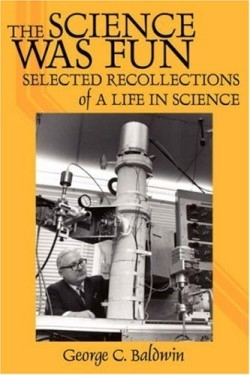The Science Was Fun
Selected Recollections of a Life in Science
The “fun” in the science that 89-year-old retired physicist George Baldwin refers to in the title of his selectively culled memoir comes alive in most parts of his book. But while he admits that he “enjoyed a challenging satisfying profession” dealing with mesotrons cyclotrons betatrons “the giant dipole resonance” and the ever elusive gamma rays he also cautions his readers that some parts of his book “may occasionally even require some advanced [scientific] knowledge to appreciate [them] fully.” That being said and the flag duly noted Baldwin’s volume is still an entrancing glimpse into the fascinating life and career of a man who served America as a researcher educator inventor local politician and a scientist during some of the country’s most challenging times.
From the stories he tells it is obvious that Baldwin’s love of life equalled his love for science. Born in 1917 the sixth child of a 46-year-old mother and a 57-year-old father life as he remembers it wasn’t always rosy during “the dirty thirties.” But young George was a precocious learner steadfastly encouraged by a father who he recalls as “the most profound influence on my life.” Baldwin also remembers the early influences of an instructor who taught him to make toothpaste and hand lotions and he reminisces about Patsy Pattison since she was his first love and the cause of his first broken heart. Much later his romantic notions were shaken again when he ended his first marriage after six years of incompatibility. His much happier second marriage resulted in a Golden Wedding anniversary in 2002 with his loving wife three children and seven grandchildren there for the celebrations.
With scholarships hard work his father’s ongoing support and the influence of several teachers Baldwin graduated “magna cum laude” in 1939 from Kalamazoo College. Then it was a summer of work on a survey crew and on to graduate school at Urbana Illinois where he recalls one of his classmates was Rosalyn Yalow (nee Sussman) a future Nobel Prize winner. It was also a time when the world war raged teachers were in short supply and scientific efforts focussed on the military. He remembers the upsetting experience when none of his class of army recruits showed up because they had all been sent to Africa the night before to counter Field Marshall Rommel’s advances across the continent. And although he did make significant contributions during his career Baldwin modestly states he “made no great discoveries won no rewards nor prizes.”
An author of a highly regarded scientific text and briefly a politician Baldwin spent much of his career with General Electric despite being warned that if he went there he would “not be a scientist [but] a gadgeteer.” Although respectful of his science whether at GE the Argonne National Laboratory the Los Alamos National Laboratory or teaching at the University of Illinois or Rensselaer Polytechnic he’s not above poking a bit of fun at the wizardry of a concept to develop “a bomber that could patrol continually without refuelling stops and then if nuclear war began would crash into Moscow.”
Despite occasional lapses into scientific jargon Baldwin writes with clarity wit and a bent for trying to make his science understandable to the layman. He doesn’t always succeed but when he does the reader is bound to have as much fun reading about his life as he certainly had living and writing it.
Disclosure: This article is not an endorsement, but a review. The publisher of this book provided free copies of the book and paid a small fee to have their book reviewed by a professional reviewer. Foreword Reviews and Clarion Reviews make no guarantee that the publisher will receive a positive review. Foreword Magazine, Inc. is disclosing this in accordance with the Federal Trade Commission’s 16 CFR, Part 255.

